Laptop Mag Verdict
This stylish thin-and-light combines strong graphics with the best speakers we've heard from a 14-inch notebook.
Pros
- +
Stylish textured design
- +
Best-in-class sound quality
- +
Strong graphics scores
- +
Good keyboard and touchpad
- +
Cool temperatures
Cons
- -
Relatively short battery life
- -
A bit pricey
- -
Murky webcam images
Why you can trust Laptop Mag
It looks good, and it sounds even better. The 14-inch, 5-pound Toshiba Satellite M645 ($1,049) sports a a snazzy textured finish, plus Harmon / Kardon speakers powered by Dolby Advanced Audio Technology, producing the best sound we've heard from a laptop of this size. Thanks to its Core i5 processor and Nvidia graphics, the M645 is also a strong performer. We wish the standard battery lasted longer on a charge and the webcam provided better images, but overall this premium notebook satisfies.
Design
At 13.3 x 9 x 1.4 inches and 5 pounds, the Toshiba Satellite M645 is light enough to carry in your bag. Given its short battery life (see below), however, plan on carrying its 0.7-pound power brick anywhere and everywhere you take it.
The black chassis has a classy, understated aesthetic. The lid and deck are covered in Toshiba's Fusion X2, a textured matte finish which looks up close like a tiny series of chains and doesn't pick up fingerprints at all. The grain felt comfortable under our wrists as we typed and made a pleasant record-scratching sound when we ran our nails across it. The light-gray Fusion X2 finish on the touchpad, island-style keyboard, and touch-sensitive control bar all contribute to the handsome look.
Keyboard and Touchpad
The Toshiba Satellite M645's island keyboard has just the right amount of spacing between its keys and left and right shift keys that are nice and wide. When taking the Ten Thumbs Typing test, the comfortably-positioned keys allowed us to score a strong 92 words-per-minute with only a 1 percent error rate, 15 percent better than our typical 80 wpm performance. Still, we wish the keys offered a bit more tactile feedback.

Click to enlarge
The 3.3 x 2-inch touchpad had a smooth surface that offered just enough resistance to make navigating around the desktop easy and accurate. It also supports multitouch gestures such as pinch-to-zoom. The two discrete mouse buttons were easy to use.
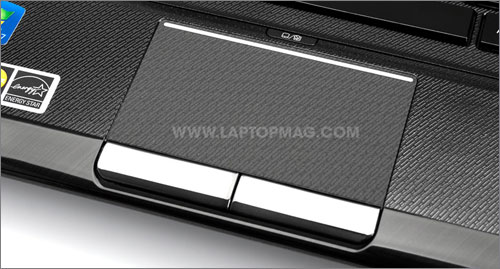
Click to enlarge
Heat
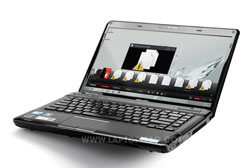
Click to enlarge
Throughout our testing, the Toshiba Satellite M645 stayed refreshingly cool. Even after playing a web video at full screen for 15 minutes, we measured the touchpad at 73 degrees Fahrenheit, the middle of the keyboard at a chilly 78 degrees, and the bottom at only 82 degrees. Considering that these points on most notebooks are well above 90 degrees and many notebook bottoms exceed 100 degrees, Toshiba's cooling achievement here is impressive.
Ports and Webcam
The Satellite M645 has a pretty standard array of ports for a mainstream notebook. On its right side are audio in/out jacks, an HDMI-out port, an eSATA/USB combo, and a VGA-out connector. The left side is adorned with a Kensington lock slot, an Ethernet port, a slot-loading DVD burner, and two more USB ports (for a total of three). The front lip of the notebook contains a 7-in-1 card reader.
Toshiba's USB ports support Sleep and Charge, which allows you to charge devices even while the notebook is in suspend mode. Even better, its audio-in jack supports Sleep and Music so you can use a 3.5-inch audio jack to connect your MP3 player and pipe tunes through the speakers while the notebook is asleep.
The VGA webcam had real difficulty handling both the fluorescent lighting of our office cubicle and the standard bulb lighting of our living room. In both cases, images were dark and noisy, with details of our face barely visible. When talking on Skype, our image was smooth but our face was barely visible.

Click to enlarge
Display and Sound
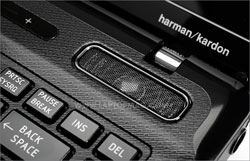
Click to enlargeThe Satellite M645's 14-inch, 1366x768 display provided sharp images and bright colors when viewed head on. However, because its surface is so glossy, images washed out significantly at even 30 degrees to the right or left of center. And if you're not using full brightness, there's a good chance you'll see your own face or the room behind you reflected in the panel.
That said, the Satellite M645 provided smooth, sharp, and noise-free playback of every video we threw at it, from a 1080p WMV file from Microsoft's HD Showcase to a 720p episode of Fringe we streamed from Fox.com to a DVD of Dark City we played in Toshiba's upscaling DVD software. In all cases, even dark areas that frequently show pixilation were smooth and colors were bright without looking oversaturated.
With its Harmon / Kardon speakers (powered by Dolby Advanced Audio) prominently mounted above the keyboard, the Satellite M645 produced the best audio we've ever heard from a mainstream notebook. When listening to a live version of the Jimi Hendrix classic "Machine Gun," we could hear a clear separation between the drums coming from one speaker and the guitar from the other, giving us the illusion that we were sitting in the front row of a concert. This sound separation was even more apparent when we listened to the jazz standard "Morning Dance" by Spyro Gyra, which includes many more instruments. At maximum volume, the sound wasn't overpowering but was loud enough to fill a medium-size room. Best of all, there was not even a hint of the distortion or tininess we normally experience on notebook speakers.
Performance
Thanks to its 2.4-GHz Intel Core i5-450M CPU and 4GB of RAM, the Satellite M645 turned in strong performance scores. On PCMark Vantage, which measures overall system performance, the M645 scored 5,329, about 25 percent faster than the thin-and-light notebook category average of 4,209 and well ahead of the Lenovo IdeaPad V460 (4,231) and Dell Inspiron 14R (4,773). However, the ASUS K42J (5,783) and Lenovo IdeaPad Y460 (6,443) both scored much higher, even though the ASUS had a slower 2.27-GHz Core i5 M430 CPU.
The Satellite M645's 5,400 rpm 500GB hard drive was a real weakness as it took a whopping 72 seconds to boot into Windows 7 Home Premium (64-bit). The drive completed the LAPTOP File Transfer test, in which we copy 4.97GB of files, in a slow 4 minutes. That's a rate of 21.2 MBps, well below the category average of 23.7 MBps and miles behind the ASUS K42J's 33.9 MBps. The good news is that you can configure the Satellite M645 with a 7,200-rpm hard drive, an upgrade we recommend.
When transcoding video in Oxelon media encoder, the Satellite M645 really showed its processing power, as it took only 52 seconds to convert a 114MB MP4 to AVI format. That's 13 seconds faster than the category average, and even a bit faster than competitors like the ASUS K42J (57 seconds) and Lenovo IdeaPad Y460 (54 seconds) .
Graphics Performance
Often consumers have to choose between buying a notebook with discrete graphics chip that offers improved performance but less endurance, or one with an integrated graphics chip that consumes less power, but doesn't let you do as much. The Toshiba Satellite M645 attempts to offer the best of both worlds by employing Nvidia Optimus, a technology that automatically switches between the Satellite's discrete GeForce GT330M GPU and an integrated Intel HD graphics chip, based on what applications you're running. On all the graphics tests we performed, the system switched into discrete mode to give us some really outstanding graphics performance.
On 3DMark06, which measures overall graphics prowess, the M645 scored a whopping 6,113, more than double the category average of 2,256 and way ahead of the ASUS K42J (3,470), which pairs Nvidia Optimus technology with an Nvidia GT310M graphics chip. Among its competitors, only the Lenovo IdeaPad Y460 (7,482) with ATI Radeon HD5650 graphics did better.
It's not marketed as a gaming system, but the Toshiba M645 has enough oomph to play 3D games. The notebook notched a whopping 187 frames per second in World of Warcraft at 1024 x 768 resolution and a still-strong 55 fps at its native 1366 x 768. That number is more than double the category averages of 86 and 26 fps. Only the Lenovo IdeaPad Y460 (214 / 59 fps) did better.
On the much-more-demanding Far Cry 2, the M645 managed frame rates of 33 and 24 fps at 1024 x 768 and 1366 x 768 resolutions. Those numbers were far ahead of the category averages of 24 and 11 fps, but behind IdeaPad Y460's 74 and 35 fps.
Battery Life and Wi-Fi
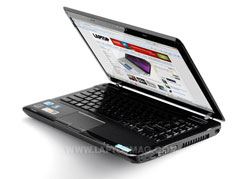
Click to enlargeDespite its power-saving Nvidia Optimus technology, the Toshiba M645 suffers from subpar battery life. The notebook lasted only 3 hours and 30 minutes on the LAPTOP Battery Test, which involves continuous surfing over Wi-Fi. That number is more than an hour shorter than the category average of 4:44 and the Lenovo Y460's 4:38. The ASUS K42J was worse, lasting only 3:21. The real culprit here is probably the low-capacity 6-cell, 4400 mAH battery. Fortunately, Toshiba offers both an increased capacity 6-cell, 5600 mAH unit and a whopping 12-cell unit for $40 and $75, respectively.
The M645's Broadcom 802.11n radio turned in subpar Wi-Fi transfer rates of 20.8 and 18.4 Mbps at a distance of 15 and 50 feet from our router. Both the ASUS K42J (36.4 / 23.5 Mbps) and the Lenovo IdeaPad Y460 (35.5 / 19.8 Mbps) did better.
Green Testing
When charging, the Satellite M645 took 1 hour and 7 minutes to reach 80 percent capacity and 1:45 to reach 100 percent. Probably because of the low-capacity battery, both times were well ahead of the category averages of 1:26 and 2:29. During this time, it used an average of 48 watts. That gives the notebook a 24.6 LAPTOP Green Efficiency rating, which is a little worse than the category average of 22 (lower is better). EPEAT has given the M645 a rating of 22 (out of 28).
Configuration Options
Though our review unit carries a sticker price of $1049, the M645 series starts at $719. Toshiba sells 7 different preconfigured models and also allows you to custom configure it online. When customizing your M645, you have a choice of either a 2.26 Core i3-350M CPU, a 2.4-GHz Core i5-450M, or a 2.93-GHz Core i5-520M CPU. You can choose between 3, 4, or 6GB of RAM. Hard drives are available in 320 or 500GB sizes, with the 500GB capacity also sold at the 7,200 rpm speed. When it comes to graphics, you can opt for integrated Intel graphics only or switchable Nvidia Graphics with Optimus. As mentioned above, batteries are available in 6-cell 4400 mAH capacity, 6-cell 5600 maH size, and 12-cell size. You can also choose Blu-ray instead of a DVD burner.
If you're not a gamer, we recommend you opt for a Core i3 CPU, 3GB of RAM, integrated graphics, a 7,200-rpm hard drive, and the higher-capacity 5600 mAH battery. That configuration will cost you only $809 and offer you much longer battery life (probably closer to 5 hours). Either way, you'll still get the same attractive chassis, great audio playback, cool temperatures, and comfortable keyboard.
Software and Warranty
The Satellite M645 comes with a nice selection of Toshiba Utilities. The most interesting of these include Toshiba Bulletin Board, a virtual peg board you can use to make photos, calendars, videos, and sticky notes readily available. We also like Toshiba ReelTime, an app that helps you find recently created files. Toshiba Eco Utility is particularly useful because it not only allows you to see exactly how many watts your computer is using at any given moment, but also lets you adjust your settings accordingly. Toshiba DVD Player one-ups the standard Windows Media Player by upscaling DVDs.
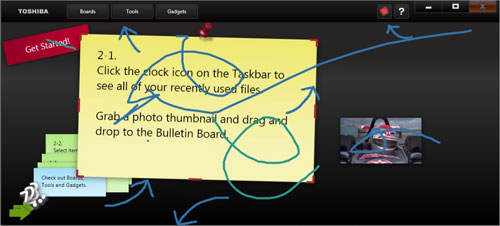
Click to enlarge
The M645 notebook comes standard with a one-year warranty on parts and labor. To see how Toshiba did on our tech support showdown, click here.
Verdict
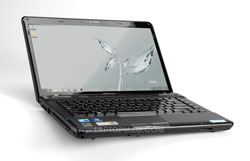
Click to enlargeIn an era when you can get a budget Core i3 notebook for less than $600 and a mainstream system with Core i5 for $700 to $800, we've come to demand more from notebooks with price tags over $1,000. And the Satellite M645 gives you more in the form of great audio quality and above-average graphics performance.
The $1,049 price of our configuration is a little high--especially when you'll need to spend a little more to get over four hours of battery life. However, when you consider that the M645 is good enough for gaming and provides strong multimedia playback, it's definitely worth considering both at this price point and may be even more compelling in a less-expensive configuration.
Toshiba Satellite M645 Specs
| Bluetooth | Bluetooth 2.1+EDR |
| Brand | Toshiba |
| CPU | 2.4-GHz Intel Core i5-450M |
| Card Slots | 7-1 card reader |
| Company Website | www.toshiba.com |
| Display Size | 14 |
| Graphics Card | Nvidia GeForce GT330M with Optimus Technology |
| Hard Drive Size | 500GB |
| Hard Drive Speed | 5,400rpm |
| Hard Drive Type | SATA Hard Drive |
| Native Resolution | 1366x768 |
| Operating System | MS Windows 7 Home Premium (64-bit) |
| Optical Drive | DVD SuperMultiDrive |
| Optical Drive Speed | 8X |
| Ports (excluding USB) | Headphone, HDMI, Ethernet, eSATA/USB, VGA, Microphone, Kensington Lock |
| RAM | 4GB |
| RAM Upgradable to | 8GB |
| Size | 13.3 x 9 x 1.39 inches |
| Touchpad Size | 3.3 x 2.0 inches |
| USB Ports | 3 |
| Video Memory | 1GB |
| Warranty/Support | 1 Year Standard Limited Warranty |
| Weight | 5 pounds |
| Wi-Fi | 802.11b/g/n |
| Wi-Fi Model | Realtek 802.11n |

